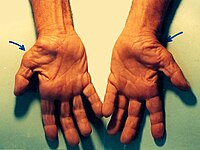
Photo from wikipedia
STUDY DESIGN Retrospective Cohort Study. OBJECTIVES Cervical radiculopathy and peripheral entrapment neuropathies often have overlapping symptoms that are difficult to distinguish on physical examination. Small-scale studies have attempted to report… Click to show full abstract
STUDY DESIGN Retrospective Cohort Study. OBJECTIVES Cervical radiculopathy and peripheral entrapment neuropathies often have overlapping symptoms that are difficult to distinguish on physical examination. Small-scale studies have attempted to report the incidence of this phenomenon, often called double crush syndrome (DCS), with varying results. The present study aims to determine the incidence of concomitant cervical radiculopathy and peripheral nerve compression and to determine if the DCS hypothesis, which states that compression of a nerve at one site leaves it more susceptible to compression at another, is valid. METHODS The PearlDiver database was queried from 2010 to 2020. The incidence of peripheral neuropathy in cervical radiculopathy was assessed. Propensity score matching was used to determine if patients with cervical radiculopathy were more likely to have peripheral nerve compression compared to controls, and vice versa, to test the DCS hypothesis. RESULTS The database contains records of 90,772 632 patients. The incidence of carpal tunnel syndrome (CTS) or peripheral ulnar nerve compression (PUnC) in cervical radiculopathy was 9.98% and 3.15%, respectively. The incidence of both carpal tunnel syndrome and PUnC in cervical radiculopathy was 1.84%. Patients with cervical radiculopathy were more likely than matched controls to have both CTS (P < .001) and PUnC (P < .001). Patients with CTS (P < .001) and with PUnC (P < .001) were more likely to have cervical radiculopathy than the control cohort. CONCLUSIONS The incidence of DCS is reported. Patients with cervical radiculopathy are more likely than matched controls to have peripheral nerve compression, and vice versa, in support of the DCS hypothesis.
Journal Title: Global spine journal
Year Published: 2022
Link to full text (if available)
Share on Social Media: Sign Up to like & get
recommendations!